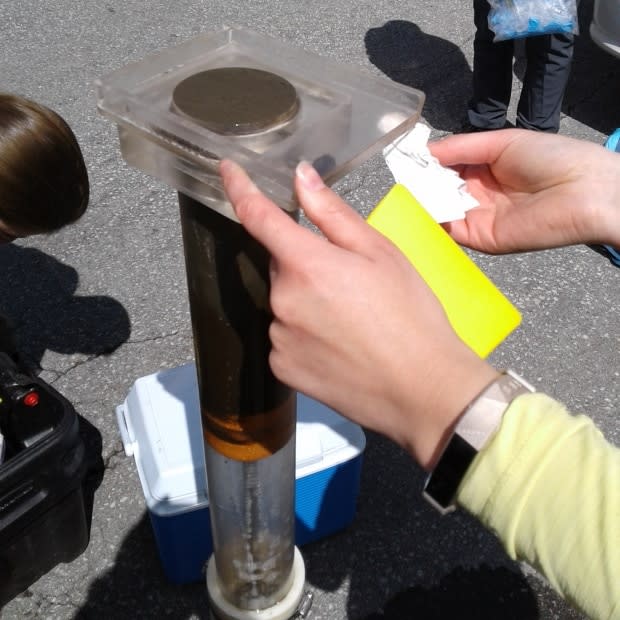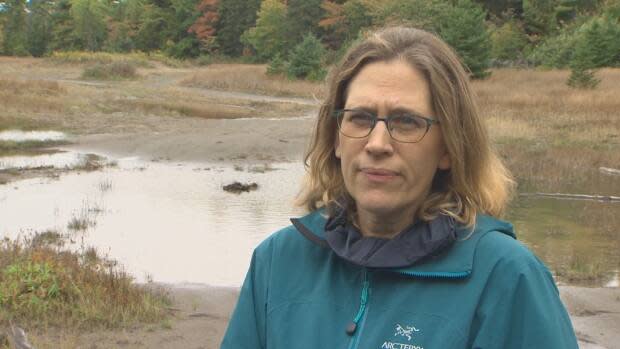How microbes could help clean up Nova Scotia's abandoned mines
Researchers from three Maritime universities are hoping microbes collected from the bottom of a lake near an abandoned gold mine in Dartmouth, N.S., will provide a model for how to clean up contaminated sites across the province in a quicker and less-intrusive way.
Last May, a research team took a boat to the middle of Lake Charles, not far from the former Montague gold mine, where extensive mining took place from 1860 to about 1940.
They lowered a plastic tube 30 metres into the water and scooped up 200-year-old sediment, which provides a snapshot of the lake before, during and after the mine was in operation.
Josh Kurek, an associate professor of environmental science at Mount Allison University in Sackville, N.B., said preliminary findings show a striking increase in both mercury and arsenic at Lake Charles after mining began. In some cases, the concentration of toxins was 30 times higher than levels known to harm aquatic life, he said.

"Although these mines are no longer in operation and haven't been for many, many decades, there still is a risk with being exposed to fairly high levels of extremely nasty contaminants like arsenic and mercury," Kurek said.
Last year, Halifax Regional Municipality cautioned that Barry's Run, which connects Lake Charles to the Montague gold mine, was not safe for people to use.
Kurek said it appears the arsenic in the lake stays locked in the sediment for years, and that it actually rises up within the sediment and potentially into the water.
But while the lake bottom reveals the damage mining can do to the surrounding environment, there could be solutions buried in the sediment too.

The research team, led by Linda Campbell at Saint Mary's University in Halifax, is now trying to see whether microbes in the sediment can help remediate mine sites in the future.
"We want to develop a treatment that you would apply … on the site and that would block the arsenic and the mercury from accumulating, and you could either then replant with native plant seeds or just allow the site to recover naturally," she told CBC's Information Morning.
How can microbes help?
The key to this treatment lies in the DNA of certain microbes that are able to make some contaminants less harmful.
Landon Getz, a microbiology PhD student at Dalhousie University in Halifax, said that's the beauty of working with microbes. If you can think of something you want done, there's probably a microbe already doing it.
"If we can identify what … microbes are actually doing this work to convert the bio-available toxic chemicals into less toxic ones, we might be able to speed up remediation in orders of decades," Getz said.
This phase of the team's research is still preliminary, but it's promising, Campbell said.
Thanks to more funding, researchers will reconvene in the lab this fall to test microbes in artificial ecosystems, called mesocosms, she said.
"We hope to start with a beaker mesocosm system in our laboratory to test a few simple interactions, then scale up to larger wetland mesocosms to see how our approaches work in more complex settings," Campbell said in an email. "That way we can make sure our approaches are safe, effective, environmentally friendly and practical."

She hopes the treatment her team develops will be used alongside other remediation efforts now that the province is working to clean up dozens of historic mine sites littered across the province.
Last year, the Nova Scotia government announced it would spend $48 million to clean up two of the most contaminated former mines — Montague Gold Mines and Goldenville on the Eastern Shore.
"Remediation projects often must incorporate an array of approaches depending on the site," Campbell said. "Being able to treat the contaminated site to reduce the movement of toxic contaminants there, and to support the natural recovery of more healthy ecosystems would be an excellent option to have."

Nova Scotia's acting auditor general released a report last week pointing to major gaps in how the province manages contaminated sites.
While Campbell applauds the province's commitment to addressing issues raised by the auditor general, she said the work can't wait.
"Over a hundred years later, it's still an issue, and we can't afford to wait another 100 years," she said.
Department of Lands and Forestry spokesperson Marla MacInnis said the province has hired a consultant to create a closure plan for the Montague and Goldenville mines, and it is working on assessing and developing plans for the 67 remaining former mine sites.
"These sites don't pose an immediate risk, but they need to be managed and we have made a significant investment to mitigate the impact," she said.
MORE TOP STORIES


